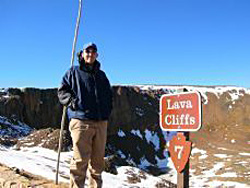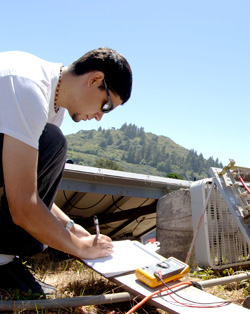Two HSU alumni, Douglas Saucedo (’05, Environmental Resources Engineering) and Bryan Jungers (’04 Environmental Resources Engineering) stepped up to the front to delivered the long anticipated presentation: “Kicking the Habit: A 12-Step Program for Oil Addicts”.

Saucedo and Jungers are currently working on research and development for hybrid electric vehicles at UC Davis. Why they do what they do goes a little something like this: America is the number one consumer of oil. The number one use for that oil is in our vehicle fleet and the most consumptive faction of that vehicle fleet is the light duty vehicles, or personal automobiles.
“The best way I see to make an impact,” said Jungers while pointing to a pie chart, “is to focus on this sector here.”
Before he started advocating for the end of America’s oil addiction, Jungers spent his youth working on cars with his father and always had a knack for math. In his teenage years he taught at an environmental camp. When it came time for college, Jungers found himself attracted to Humboldt State because of its environmental focus, its engineering programs and particularly because of Shatz Energy Resources Laboratory.

While reflecting on his interest in the advancement of the auto industry he said, “I want to work on fixing environmental problems and social issues and I think that this combines those two worlds.”
Jungers and Saucedo were both in the ERE program at HSU when they officially founded the Renewable Energy Student Union in 2004. The club is famous at HSU for attracting bright and enthusiastic students to work on sustainable energy projects on campus, in the community and beyond.
Saucedo was on the winning team that designed the hydrogen fueling station at HSU during the 2005 National Hydrogen H2U Student Design competition. “I enjoy applying my knowledge of engineering, applied mathematics and optimization to new and challenging problems,” said Saucedo.
He does not foresee a sudden shift from petroleum powered cars to electric cars, but, “I can’t think of a major auto dealer who is not working on some sort of plug-in hybrid,” Saucedo said.
They are accomplishing what Jungers calls their “tongue in cheek ‘half price 12-Step Program’.” This is the six step program that calls on us to 1, Acknowledge the situation 2, Admit there is a problem 3, Accept responsibility for change 4, Seek understanding 5, Seek a new path 6, Share what you find with others.
They came to HSU to become environmental engineers, they recognized one of the biggest environmental problems Americans face, they set off to research a better way and now they are sharing what they know with others.
Even though the current consumer demand is low for these electric hybrids, Junger stays optimistic. “I think people might be confused by terminology, but once they see them and understand, then I think they will change.”